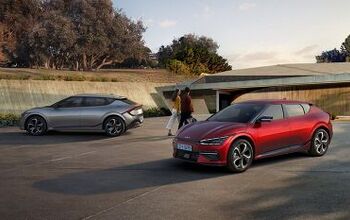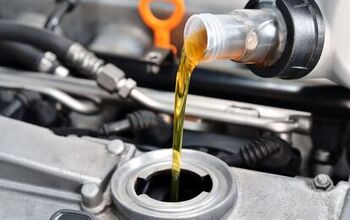Chevy Performance Reveals 10.3-Liter Crate V8 With 1,000 HP

On Wednesday, Chevrolet Performance announced the ZZ632/1000 — a naturally aspirated 632-cubic-inch (10,348 cc) V8 producing 1,004 horsepower and 876 lb-ft of torque on pump gasoline.
While 100 hp per liter may not be an engineering marvel today, delivering a crate motor that’s sized to embarrass every other powertrain installed into a production vehicle is an achievement in itself. This 10.3-liter behemoth makes the 8.4-liter V10 installed in Dodge’s Viper (rest in peace) look like it’s supposed to be fitted to a riding lawnmower. Of course, it’s also huge in comparison to literally every powertrain we’ve seen on a project car that didn’t source its parts from vintage aircraft.
This obviously isn’t the kind of motor you would buy for tooling around town. It’s specifically designed for drag racing applications, with Chevy saying the iron block endured 200 simulated runs on a dyno without a single hiccup. That’s bound to change once you hook up the necessary hardware to sync it to the wheels. But building up a car that can reliably endure the physics accessible through the ZZ632 (or a floor pan that can catch errant driveshafts) is technically on you.
From Chevrolet Performance:
The Big Block V-8 reaches peak power at 6,600 rpm and revs to a recommended maximum of 7,000 rpm. Fuel is delivered by eight port injectors with the engine breathing through CNC-machined high-flow aluminum cylinder heads featuring symmetrical ports. While Big Blocks have traditionally been designed with variations in port shape from cylinder to cylinder, all eight intake ports of the ZZ632 have the same length, volume and layout. Similarly, all of the ZZ632’s exhaust ports are identical. This symmetry ensures individual cylinders all produce similar power.
These RS-X Symmetrical Port cylinder heads are named for powertrain engineer Ron Sperry, who designed them as one of his final accomplishments in more than 50 years working on General Motors performance and racing engines. Sperry also introduced symmetrical ports to Chevy’s iconic Small Block V-8 with the Gen III LS1 engine that debuted in the 1997 Chevrolet Corvette.
The unit shares a mold with Chevrolet Performance’s ZZ572 crate engines, with the manufacturer having bored out the cylinders by 0.04 inches and lengthened the stroke by 0.375 inches. Engineers were likewise required to modify both the block and the connecting rods to make room for the larger explosions. No replacement for displacement and all that.
“This is the biggest, baddest crate engine we’ve ever built,” Russ O’Blenes, GM director of the Performance and Racing Propulsion Team, said upon the motor’s release. “The ZZ632 sits at the top of our unparalleled crate engine lineup as the king of performance. It delivers incredible power, and it does it on pump gas.”
Considering the similarities to the ZZ572, it probably won’t be long before we begin seeing the 10-liter big block undergoing performance modifications to see exactly how far north of 1,004 horsepower it’s willing to go. I frankly cannot wait to see how the ZZ632 compares to the Hellephant 426 Supercharged HEMI V8 (1,00o hp and 950 lb-ft of torque) offered by Mopar once they’re both sporting forced induction.
Deliveries are said to commence early in 2022. However, customers can see it for themselves from November 2nd to the 5th at the 2021 SEMA Show in Las Vegas. Pricing is TBD but it’s bound to reside well above the $16,000 General Motors is currently asking for the deluxe variants of the ZZ572/720R.
[Images: General Motors]

A staunch consumer advocate tracking industry trends and regulation. Before joining TTAC, Matt spent a decade working for marketing and research firms based in NYC. Clients included several of the world’s largest automakers, global tire brands, and aftermarket part suppliers. Dissatisfied with the corporate world and resentful of having to wear suits everyday, he pivoted to writing about cars. Since then, that man has become an ardent supporter of the right-to-repair movement, been interviewed on the auto industry by national radio broadcasts, driven more rental cars than anyone ever should, participated in amateur rallying events, and received the requisite minimum training as sanctioned by the SCCA. Handy with a wrench, Matt grew up surrounded by Detroit auto workers and managed to get a pizza delivery job before he was legally eligible. He later found himself driving box trucks through Manhattan, guaranteeing future sympathy for actual truckers. He continues to conduct research pertaining to the automotive sector as an independent contractor and has since moved back to his native Michigan, closer to where the cars are born. A contrarian, Matt claims to prefer understeer — stating that front and all-wheel drive vehicles cater best to his driving style.
More by Matt Posky
Latest Car Reviews
Read moreLatest Product Reviews
Read moreRecent Comments
- Turbo Is Black Magic My wife had one of these back in 06, did a ton of work to it… supercharger, full exhaust, full suspension.. it was a blast to drive even though it was still hilariously slow. Great for drive in nights, open the hatch fold the seats flat and just relax.Also this thing is a great example of how far we have come in crash safety even since just 2005… go look at these old crash tests now and I cringe at what a modern electric tank would do to this thing.
- MaintenanceCosts Whenever the topic of the xB comes up…Me: "The style is fun. The combination of the box shape and the aggressive detailing is very JDM."Wife: "Those are ghetto."Me: "They're smaller than a Corolla outside and have the space of a RAV4 inside."Wife: "Those are ghetto."Me: "They're kind of fun to drive with a stick."Wife: "Those are ghetto."It's one of a few cars (including its fellow box, the Ford Flex) on which we will just never see eye to eye.
- Oberkanone The alternative is a more expensive SUV. Yes, it will be missed.
- Ajla I did like this one.
- Zerofoo No, I won't miss this Chevrolet Malibu. It's a completely forgettable car. Who in their right mind would choose this over a V8 powered charger at the rental counter? Even the V6 charger is a far better drive.



































Comments
Join the conversation
I think I'd like to order one as a living room sculpture.
For perspective the ME109 and Spitfire off Battle of Briton times were making about this HP. With V-12's. And more cube's. And Super Chargers...